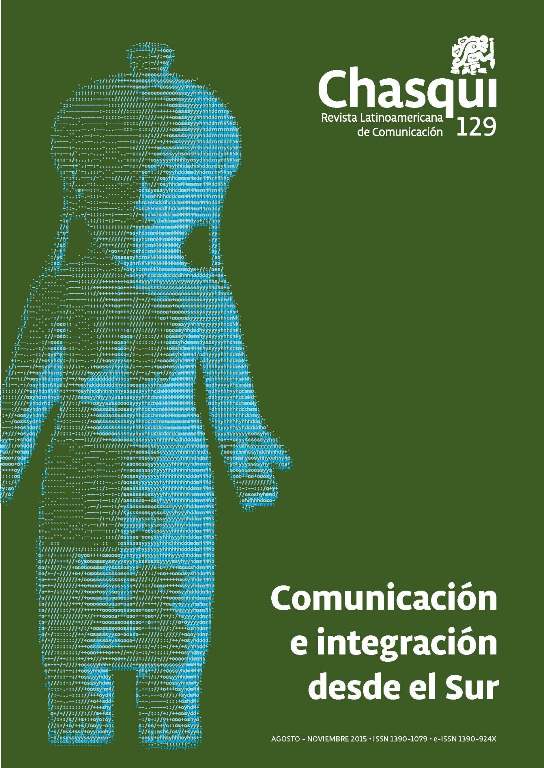Audiovisual activism practices with an aim of social integration: the case of the group Cinema without Author (CsA)
DOI:
https://doi.org/10.16921/chasqui.v0i129.2518Keywords:
audiovisual activism, social integration, Cinema without Author, social empowermentAbstract
In recent years a tendency towards the use of audiovisual technology is increasing by social and community groups: with an objective for a transformation of social realities, these practices have focused on promoting the empowerment process as a generator of meaning and symbolic universes. The text reflects on the audiovisual and social integration from a generalist approach, according to its precedents. Firstly, we compose a theoretical exploration to define the concept of audiovisual activism and its possibilities for education, activism and social integration; secondly, an analysis is discussed about the work of the group called Cinema without author (CsA). Its “open audiovisual works” are developing processes of social integration with communities and disadvantaged groups.References
Brisset, D. E. (2011). Los medios digitales de comunicación: Experiencias de activismo audiovisual, 88. Recuperado de http://telos.fundaciontelefonica.com/seccion=1268&idioma=es_ES&id=2011072908520001&activo=6.do#.
Burin, D. & Heras, A. I. (2009). Contextos de producción y de uso del video en Ciencias Sociales. Actas de la Reunión Científica “Memorias Visuales, entre las representaciones colectivas y las propuestas académicas”. Buenos Aires: Fundación Walter Benjamin.
Calvelo, M. (1980). Una hipótesis de trabajo sobre la educación. Lima: Proyecto FAO-PNUD PER 073.
Colectivo Subtramas (2003). Presentación proyecto. Recuperado de http://www.workingimages.org/contenido/investi gacion-subtramas.
Deleuze, G. (1995). Conversaciones. Madrid: Pretextos.
Didi-Huberman, G. (2010). Las imágenes son un espacio de lucha, Entrevista con Amador Fernández-Savater. Recuperado de http://drogoliticas.blogspot.com.
Galán Zarzuelo, M. (2012). El fotograma disidente: del cine militante al videoactivismo. Cambios históricos, políticos y culturales en el cine y la televisión. Congreso Internacional Hispanic Cinemas: En Transición. Madrid: Universidad
Carlos III.
Hernández Galárraga, E. (2002). El vídeo como medio de educación popular. Recuperado de http://tecnologiaedu.us.es/nweb/htm/pdf/125.pdf.
Johansson, L. (1999). Participatory Video and PRA: Acknowledging the politics of Empowerment. Forests, Trees and People, 40/41, 21-23.
Korstanje, F.; Herscher, C.; Schowald, J.; Marcos, S. & Villanueva, J. (1995). La pedagogía masiva audiovisual. Una propuesta de integración del saber popular y el saber académico. Una experiencia de capacitación en Tucumán. Fuder. Fundación para el desarrollo Regional. 1º Congreso de investigación en Ciencias Sociales. Facultad de Filosofía y Letras. Tucumán: Universidad Nacional de Tucumán.
Laddaga, R. (2006). Estética de la emergencia: Sobre la reorientación actual de las artes. Buenos Aires: Adriana Hidalgo Editora.
Linares, A. (1976). Cine militante. Madrid: Castellote.
Mateos, C. & Lanchares, L. (2014). Languages of Video-Activism. VideoActivism Workshop Bristol Radical Film Festival, 3-9 marzo.
Montero, D. & Moreno, J. M. (2014). El cambio social a través de las imágenes. Madrid: Catarata.
Montero, D. (2014). Occuppy Filmmaking: the cinema of collectivities in the work of Cine sin Autor (CsA). Comunicación presentada en Global Conference on communication for Development Voice and Matter. 17-24 septiembre 2014). Roskilde, Malmö, Orencoom. Recuperado de http://voiceandmatter.net.
Nibblet, B. (2014). Narrating activist education: teacher´s stories of affecting social and political change. Thunder Bay, ON: University of Lakehead.
Ortuño, P. (2013). Antecedentes del vídeo participativo como alternativa a la televisión comercial: nuevas propuestas online. Doc online, 14. Recuperado de http://www.doc.ubi.pt/14/dossier_pedro_ortuno.pdfs.
Parr, H. (2007). Collaborative film-making as process, method and text in mental health research. Cultural Geographies, 14, 114-138.
Rancière, J. (2005). Sobre políticas estéticas. Barcelona: Macba y Servei de Publicaciones de la Universidad de Barcelona.
Sádaba Rodríguez, Í. & Roig Domínguez, G. (2004). El movimiento de okupación ante las nuevas tecnologías okupas en las redes. En R. Adell & M. Martínez, ¿Dónde están las llaves? El movimiento okupa: prácticas y contextos sociales (pp. 267-291). Madrid: Libros de la catarata.
Sedeño Valdellós, A. (2013). Cine sin Autor como pedagogía crítica audiovisual. Bases teóricas, antecedentes y postura crítica. Communication Papers, 2, 91-97.
Tudurí, G. (2008). Manifiesto del Cine sin Autor 1.0. Realismo social extremo en el siglo XXI. Cienpozuelos: Centro de Documentación Crítica. Recuperado de http://www.cinesinautor.es/images/uploads/documents/371a86bba8d99bbeb290afc3dfdb266ac2840140.pdf.
Tudurí, G. (2011). Movimiento 15M. Contrapoder: la cámara anónima contra la cámara capitalista. El cine asambleario como horizonte. Recuperado de http://cinesinautor.blogspot.com/2011/06/movimiento-15-m-contrapoder-la-camara.html.
Tudurí, G. (2012). Cine XXI. La política de la colectividad. Manifiesto de Cine sin Autor 2.0. Murcia: Servicio de Publicaciones de la Universidad de Murcia. Recuperado de http://www.cinesinautor.es/images/uploads/documents/a3c6c9d9a 9e43779f07b2185b06e3357fc201054.pdf.
Virno, P. (2003). Gramática de la multitud. Para un análisis de las formas de vida contemporáneas. Madrid: Traficantes de sueños.
White, S. (ed.) (2003). Participatory Video. Images that transform and empower. Thounsand Oak: Sage.
Widgington, D. (2005). Screening revolution. FAQS about video activism. En A. Langlois, & F. Dubois (2005), Autonomous Media. Activating Resistance & Dissent (pp. 103-121). Montreal: Cumulus Press.
Downloads
Published
Issue
Section
License
- Authors retain copyright and grant the journal right of first publication with the work simultaneously licensed under a Creative Commons Attribution-NoDerivs License (CC BY-ND) that allows others to share the work with an acknowledgement of the work's authorship and initial publication in this journal.
- Authors are able to enter into separate, additional contractual arrangements for the non-exclusive distribution of the journal's published version of the work (e.g., post it to an institutional repository or publish it in a book), with an acknowledgement of its initial publication in this journal.
- Authors are permitted and encouraged to post their work online.

